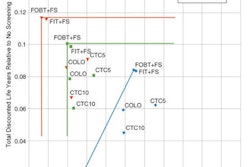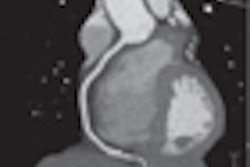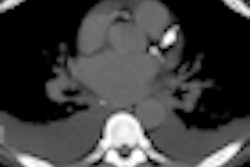In a new study of more than 2,000 patients, virtual colonoscopy found nearly as many cancers outside the colon as inside it. This ability to detect serious extracolonic abnormalities is a major benefit of VC screening, researchers report in the September issue of the American Journal of Roentgenology.
The study, from Walter Reed Army Medical Center in Washington, DC, assessed both the clinical and economic effects of extracolonic findings in a population of 2,277 patients who were screened with VC (also known as CT colonography or CTC) at Walter Reed between August 2003 and June 2006 (AJR, September 2010, Vol. 195:3, pp. 677-686).
The researchers found that VC's ability to detect extracolonic findings may increase the yield of colorectal cancer screening, thus enhancing CTC as a major screening technique, according to lead author Ganesh Veerappan, MD.
"CTC not only identifies [colorectal cancer] but also doubles the yield of identifying significant early extracolonic lesions, resulting in lives saved," Veerappan said.
Increased yield
Previous studies have shown that about 10% to 23% of all patients undergoing virtual colonoscopy have significant findings requiring further radiologic evaluation. Although detecting extracolonic findings isn't VC's primary aim, radiologists are responsible for evaluating both intracolonic and extracolonic findings in CTC, which includes the entire abdomen and pelvis, similar to a CT scan.
The cohort of 2,277 patients (mean age, 59 ± 11 years; 60% white; 56% male) underwent standard bowel preparation using either polyethylene glycol or a split dose of 45 mL of sodium phosphate the day before the procedure, plus a single dose of 2% barium sulfate (250 mL) and diatrizoate sodium (60 mL) to tag the stool and colonic fluid.
Colonic insufflation with CO2 was performed using an automated delivery system (ProtoCO2L, Bracco Diagnostics, Princeton, NJ). The images were acquired using several models of MDCT scanners (8-, 16-, or 64-detector-row scanners; LightSpeed, GE Healthcare, Chalfont St. Giles, U.K.) at 1.25-mm collimation, 1-mm reconstruction interval, 100 mAs, and 120 kVp, during a single breath-hold. Scans were acquired both prone and supine in all cases. The radiologists reviewed images using 3D colon software (V3D-Colon, Viatronix, Stony Brook, NY).
In all, 14 trained and experienced radiologists read the exams, categorizing extracolonic findings using the CTC reporting software, which classifies extracolonic findings according to significance:
- E0: Limited exam -- compromised by artifact; evaluation of soft tissues is severely limited
- E1: Normal examination or anatomic variant -- no extracolonic abnormalities visible (example: retroaortic left renal vein)
- E2: Clinically unimportant finding -- no workup indicated (examples: simple renal cyst, gallstones, hiatal hernia)
- E3: Likely unimportant finding, incompletely characterized -- workup may be indicated (examples: complex renal cyst, lung nodule)
- E4: Potentially important finding -- communicate to referring physician as per accepted practice guidelines (examples: ovarian mass, kidney mass, abdominal aortic aneurysm [5 cm], lymphadenopathy)
All final diagnoses, surgeries, malignancies, and costs of diagnostic radiology procedures were calculated for each category of extracolonic finding.
The researchers found extracolonic abnormalities in 1,037 patients (46%), including 787 (34.5%) that were deemed insignificant, as well as 240 (11.0%) significant findings. A total of 787 (34.6%) patients were classified as E2, 211 patients (9.3%) as E3, and 39 patients (1.7%) as E4.
Eighty percent of the E2 findings were renal cysts, nephrolithiasis, hiatal hernias, or benign liver cysts, which, by definition, were not sent for further workup. Most of the E3 findings were pulmonary nodules larger than 5 mm and complex renal and ovarian cysts, the group reported.
The most common E4 finding was a kidney mass; this finding made up 41% (16/39) of all E4 findings. Pelvic, ovarian, and lung masses made up most of the rest. In all, the study found seven high-risk lesions (six extracolonic malignancies and one large aortic aneurysm) in patients with significant findings.
CTC also identified six colon cancers and three adenomas with high-grade dysplasia.
Costs
Evaluating the significant findings generated 280 radiology procedures and 19 surgeries over a mean follow-up time of 19 ± 10 months, the group reported. The total cost of the radiology studies was $113,179.
The 167 patients with E3 findings generated 158 CT scans, 47 ultrasound scans, five PET scans, nine MRI scans, and 14 other studies, generating a total radiology cost of $87,911, Veerappan and his team wrote. Evaluation of the 32 E4 patients who had follow-up generated 24 CT scans, 10 ultrasound scans, five PET scans, four MRI scans, an echocardiogram, an upper endoscopy, an endoscopic ultrasound, a bronchoscopy, and an abdominal radiograph, for a total cost of $25,268. The total cost of additional workup was $57 per patient.
Nineteen surgeries were performed to work up the E3 and E4 groups, yielding six extracolonic malignancies. "Patients in the E4 group were significantly more likely to require diagnostic surgery to work up extracolonic findings than were patients in the E3 group" (37.5% [12/32] versus 4.2% [7/167]; p < 0.0001), the authors wrote.
"Interestingly, none of the eight patients (two in the E3 group and six in the E4 group) who underwent surgery for pelvic masses ultimately had a malignancy," they wrote. "Overall, only 0.83% (19/2,277) patients undergoing screening CTC required surgical evaluation as part of the workup."
When extracolonic findings were included, CTC increased the odds of detecting high-risk lesions by 78% (p = 0.0156). Of the 16 intracolonic and extracolonic high-risk lesions, 11 (69%) underwent curative resection and five of 11 (44.4%) were extracolonic.
"This study shows that significant extracolonic lesions identified during CTC increased the overall diagnostic yield of this examination," the team wrote, adding that clinically significant findings requiring urgent management increased by 78% (16 versus 9; p = 0.0156), which resulted "in the discovery of six more cancers and a large aortic aneurysm," the authors wrote. "Interestingly, CTC used for [colorectal cancer] screening identified almost as many extracolonic cancers as intracolonic cancers."
"There were a total of six extracolonic cancers (one lymphoma, three renal cell cancers, and two lung cancers) identified in this population, in addition to six colon cancers and three adenomas with high-grade dysplasia," the authors wrote. "Importantly, 66.7% (4/6) of these extracolonic malignancies underwent curative resection, compared with 50% (3/6) of colon cancers identified."
The imaging exams used to evaluate extracolonic findings increased the estimated cost of colon screening by $57 per patient, to use a "straightforward cost-effectiveness assessment examining short-term radiology costs" that has been duplicated in several other studies with similar results.
Higher costs could be expected if the costs were to incorporate "every aspect of medical and clerical costs," which was attempted in a study by Gluecker and colleagues, they noted.
The Walter Reed study's retrospective design brings limitations as well as benefits. While the inability to control for patients' follow-up patterns is a drawback, retrospective studies yield important information about outcomes, especially in the military, where "an electronic medical record spans the entire military worldwide, the authors wrote.
"Because of the lack of IV contrast material and the low dose of radiation, the sensitivity of CTC for identifying extracolonic lesions is much lower than that for a regular CT scan," they wrote. "This message needs to be communicated to referring physicians and patients undergoing CTC for screening."
VC does double duty as a screening exam, detecting nearly as many significant findings outside the colon as within it, the authors concluded. "These results represent a compelling reason to consider CTC either as an alternative to optical colonoscopy [colorectal cancer] screening or as a one-time procedure to identify significant treatable intracolonic and extracolonic lesions."
By Eric Barnes
AuntMinnie.com staff writer
August 24, 2010
Related Reading
VC not cost-effective -- unless screening rates rise, July 27, 2010
Screening VC sorts out incidental kidney lesions, June 15, 2010
5-year C-RADS analysis shows stable VC screening results, May 6, 2010
Significant extracolonic cancer found in VC screening patients, June 12, 2007
Low incidence of serious extracolonic findings seen in VC screening population, December 18, 2006
Copyright © 2010 AuntMinnie.com



















